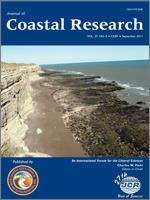The present contribution aims to provide an insight into the sediment dynamics of the Bay of Marseille (BoM), France, an area characterised by a mostly rocky, steep-sloped, and protected shoreline. In terms of sediment composition, the northern part of the study area is dominated by fines, whereas sands of mean grain size 0.2 < d50 < 1 mm occur at most other locations. Posidonia oceanica meadows occupy many nearshore areas. Critical bed-shear stress was determined through tests in a unidirectional flume using 15 natural cores. Measured values ranged from 0.04 N/m2 to 0.46 N/m2 and were expressed as a function of the logarithm of d50. Mud content had no observable effect on sediment cohesion, whereas a weak positive trend between critical shear stress and clay content was discerned. Autonomous benthic stations (Acoustic Doppler Current Profiler/Conductivity, Temperature, Depth/Turbidity/ALTUS Data Collection System) were deployed for periods of 2–3 months, and several suspension and erosion events were identified for significant wave heights exceeding 1.5 m. Grain-size trends showed that the protected BoM appeared to favour accumulation of sediments advected from the surrounding areas. The southern sector of the BoM was found to be the area with the highest sediment agitation and erosion rates but with weak transport trends. The northern sector, exposed to dominant SW waves, was shown to be the second most active area in terms of sediment dynamics, whereas the several Posidonia oceanica meadows and sheltered locations along the study area appeared to be possible sediment sinks. The latter included locations close to port installations and the western part of the Cortiou area, known to have water quality issues, which, according to the present findings, are linked to low sediment mobility and/or dispersion of pollutants.
How to translate text using browser tools
1 September 2011
Sediment Dynamics in the Bay of Marseille, Gulf of Lions (France): Hydrodynamic Forcing vs. Bed Erodibility
Michalis I. Vousdoukas,
Romaric Verney,
Francois Dufois,
Christel Pinazo,
Didier Sauzade,
Samuel Meule,
Philippe Cann,
Theocharis A. Plomaritis
ACCESS THE FULL ARTICLE

Journal of Coastal Research
Vol. 27 • No. 5
September 2011
Vol. 27 • No. 5
September 2011
bed erodibility
fate of pollutants
grain size trends analysis
Mediterranean Sea
Sediment Suspension
sediment transport




